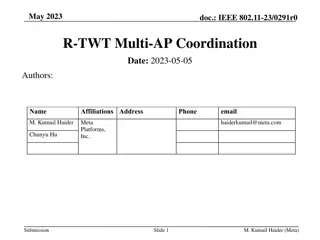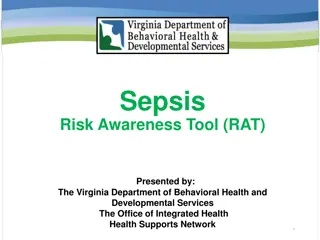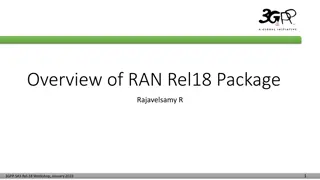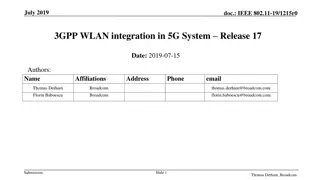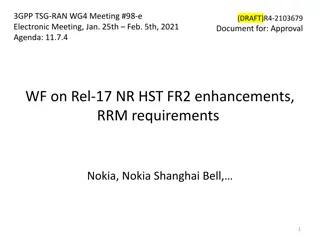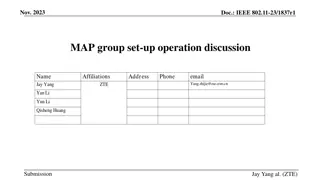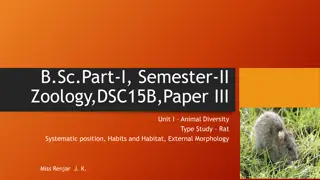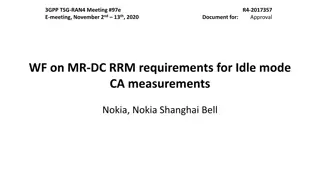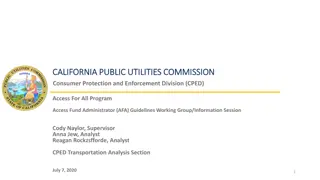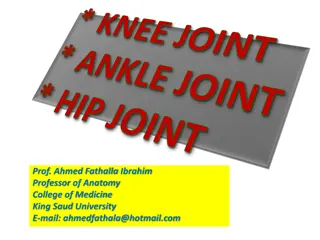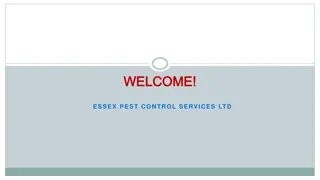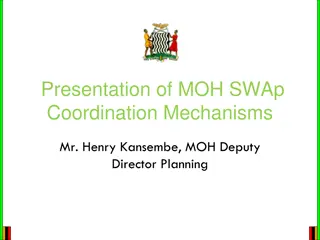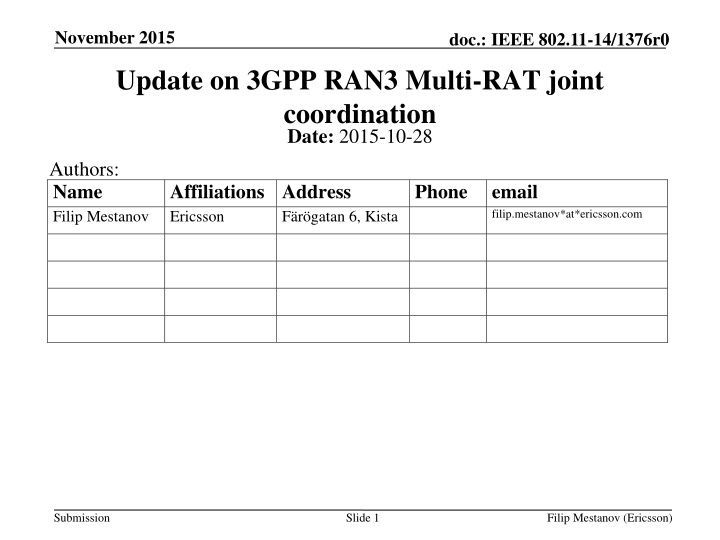
Update on 3GPP RAN3 Multi-RAT Joint Coordination in November 2015
This document provides an update on the progress of the 3GPP Multi-RAT joint coordination work, focusing on improving coordination between different Radio Access Technologies (RATs) such as LTE, UMTS, GSM, CDMA, and WLAN. Initiatives like LTE-WLAN Radio Level Integration and Interworking Enhancement are discussed, highlighting the standards and goals set during this period.
Download Presentation

Please find below an Image/Link to download the presentation.
The content on the website is provided AS IS for your information and personal use only. It may not be sold, licensed, or shared on other websites without obtaining consent from the author. If you encounter any issues during the download, it is possible that the publisher has removed the file from their server.
You are allowed to download the files provided on this website for personal or commercial use, subject to the condition that they are used lawfully. All files are the property of their respective owners.
The content on the website is provided AS IS for your information and personal use only. It may not be sold, licensed, or shared on other websites without obtaining consent from the author.
E N D
Presentation Transcript
November 2015 doc.: IEEE 802.11-14/1376r0 Update on 3GPP RAN3 Multi-RAT joint coordination Date: 2015-10-28 Authors: Name Filip Mestanov Affiliations Address Ericsson Phone email filip.mestanov*at*ericsson.com F r gatan 6, Kista Submission Slide 1 Filip Mestanov (Ericsson)
November 2015 doc.: IEEE 802.11-14/1376r0 Abstract This presentation gives a short update on the current status of the 3GPP Multi-RAT joint coordination (FS_MultiRAT_JC) work item Submission Slide 2 Filip Mestanov (Ericsson)
November 2015 doc.: IEEE 802.11-14/1376r0 Background (1/2) In 3GPP Release 13, a Study on Multiple Radio Access Technology (Multi-RAT) joint coordination was started with the goal of improving the overall coordination between different RATs (LTE/UMTS/GSM/CDMA/WLAN) for operators with multi-RAT networks Clause 5.1 of TR 37.800 defined Coordination involving 3GPP- WLAN MME S1 Xw WLAN access eNB WT Aim was to: a) report UE throughput in WLAN in order to follow-up on potential performance impacts and b) improve the eNB/NB broadcast performance for the Rel-12 WLAN interworking feature c) not impact 3GPP core nodes (MME, S-GW, P-GW) or other specifications (e.g., IEEE, WFA, WBA), pure RAN solution Figure 1: Architecture for the Xw interface Parameters to be exchanged from the WLAN to 3GPP nodes: BSS Load, UE Average data rate, WLAN identifiers (SSID, BSSID, HESSID), BSS Average Access Delay, BSS AC Access Delay, WAN Metrics The WLAN Termination (WT) was introduced as a logical node where the Xw interface terminates The placement and implementation of WT in WLAN is out of 3GPP scope However WT functions and behaviour are specified by 3GPP The work item was approved at RAN#68 Submission Slide 3 Filip Mestanov (Ericsson)
November 2015 doc.: IEEE 802.11-14/1376r0 Background (2/2) However, during the progress of the RAN3 work, a new RAN2 WI was approved: LTE-WLAN Radio Level Integration and Interworking Enhancement (RP-150510), which was considered to have impact on the Xw interface The main goals were: 1. Enhance the Rel. 12 WLAN interworking feature with full network control (LWI) 2. Tight LTE-WLAN access aggregation at radio level (LWA), which follows the Dual-Connectivity concept specified in Rel. 12) Note: Subsequently, this work was extended for access aggregation over legacy WLAN (i.e., no impact on Xw): LTE-WLAN RAN Level Integration supporting legacy WLAN (RP-151615) Figure 2: Protocol stack for LTE- WLAN access aggregation The main goal was: 1. Extend the aggregation solution to provide support for legacy WLAN deployments (i.e., based on IPSec) Submission Slide 4 Filip Mestanov (Ericsson)
November 2015 doc.: IEEE 802.11-14/1376r0 The Xw interface The Xw interface is currently being standardized in RAN3. The specification follows the same principle as with other LTE network protocols (S1AP, X2AP) Several specification documents cover different aspects of the interface: 1. TS 36.461 Evolved Universal Terrestrial Radio Access Network (E-UTRAN) and Wireless LAN (WLAN); Xw layer 1 2. TS 36.462 Evolved Universal Terrestrial Radio Access Network (E-UTRAN) and Wireless LAN (WLAN); Xw signalling transport 3. TS 36.463 Evolved Universal Terrestrial Radio Access Network (E-UTRAN) and Wireless LAN (WLAN); Xw application protocol (XwAP). 4. TS 36.464 Evolved Universal Terrestrial Radio Access Network (E-UTRAN) and Wireless LAN (WLAN); Xw data transport. 5. TS 36.465 Evolved Universal Terrestrial Radio Access Network (E-UTRAN) and Wireless LAN (WLAN); Xw interface user plane protocol Submission Slide 5 Filip Mestanov (Ericsson)
November 2015 doc.: IEEE 802.11-14/1376r0 TS 36.461 Evolved Universal Terrestrial Radio Access Network (E- UTRAN) and Wireless LAN (WLAN); Xw layer 1 Latest agreements: R3-152244 It has been agreed to reuse the same L1 specification as for the S1 and X2 interfaces MME / S-GW WT eNB WT eNB Figure 3: Architecture for Xw, X2, S1 interfaces Submission Slide 6 Filip Mestanov (Ericsson)
November 2015 doc.: IEEE 802.11-14/1376r0 TS 36.462 Evolved Universal Terrestrial Radio Access Network (E- UTRAN) and Wireless LAN (WLAN); Xw signalling transport Latest agreements: R3-152247 Specifies the Signalling Transport over the Xw (how the Xw-AP signalling messages are transported over Xw) SCTP Payload Protocol Identifier assignment pending IANA approval Only one single SCTP association between eNB and WT pair allowed MME S1-MME Xw-AP Xw-C WT eNB Figure 4: C-Plane connectivity of eNB and WT for LWA SCTP IP Data link layer Physical layer Figure 5: Xw Interface Control Plane Submission Slide 7 Filip Mestanov (Ericsson)
November 2015 doc.: IEEE 802.11-14/1376r0 TS 36.463 Evolved Universal Terrestrial Radio Access Network (E- UTRAN) and Wireless LAN (WLAN); Xw application protocol (XwAP). Latest agreements: R3-152249 Control plane transport - protocols and procedures Functions of XwAP: Function eNB WT Xw SETUP REQUEST Elementary Procedure(s) Xw SETUP RESPONSE a) b) Xw Setup WT Status Reporting Initiation WT Status Reporting WLAN Load Reporting Setting up the Xw WT Configuration Update WT Configuration Update Figure 6: Example: Xw Setup, successful operation a) b) c) d) e) f) Error Indication WT Addition Preparation WT Association Confirmation eNB Initiated WT Modification WT Initiated WT Modification eNB Initiated WT Release WT Initiated WT Release LTE-WLAN Aggregation Reporting of General Error Situations Resetting the Xw Reset Human-readable (i.e., tables) and machine- readable (i.e., ASN.1) description of procedures, messages, etc. Submission Slide 8 Filip Mestanov (Ericsson)
November 2015 doc.: IEEE 802.11-14/1376r0 TS 36.464 Evolved Universal Terrestrial Radio Access Network (E-UTRAN) and Wireless LAN (WLAN); Xw data transport. and TS 36.465 Evolved Universal Terrestrial Radio Access Network (E-UTRAN) and Wireless LAN (WLAN); Xw interface user plane protocol Latest agreements: R3-152213 User plane transport protocols and procedures Xw-U protocol S-GW S1-U User plane PDUs Xw-U WT eNB Figure 7: U-Plane connectivity of eNB and WT for LWA GTP-U UDP IP Data link layer Physical layer Figure 8: Xw Interface User Plane Submission Slide 9 Filip Mestanov (Ericsson)
November 2015 doc.: IEEE 802.11-14/1376r0 What does this all mean for IEEE? The requirement from the beginning was to not have impact on IEEE protocols The WLAN Termination (WT) behavior is defined only in the minimum terms required for the 3GPP-defined functionality Implementation, functional split, deployment options are up to vendor choices; e.g., WT could be implemented as: - interworking function on top of an AC - co-located in an AP - co-located in any other node However, e.g., UE Average data rate, WAN metrics not part of IEEE specs. Anything to do be done here? Submission Slide 10 Filip Mestanov (Ericsson)

